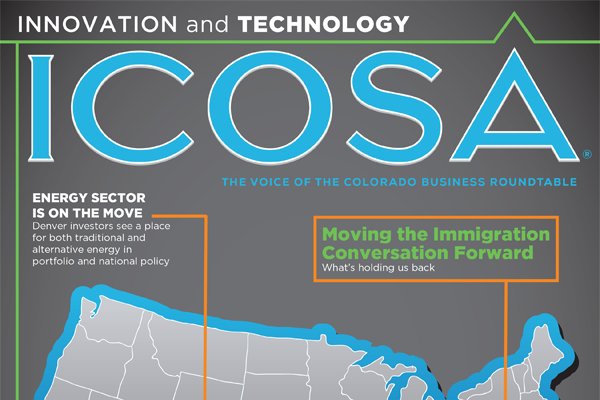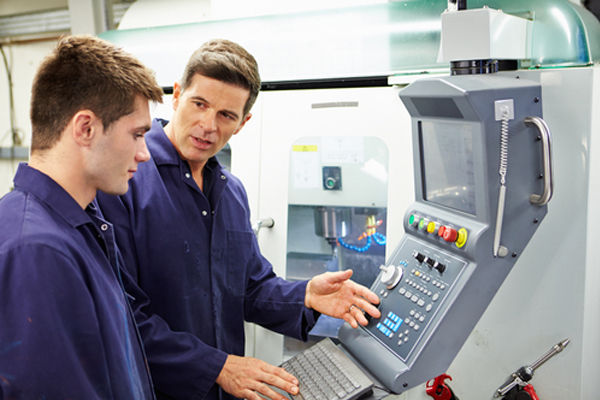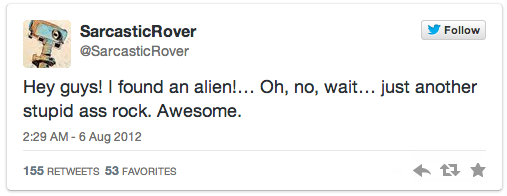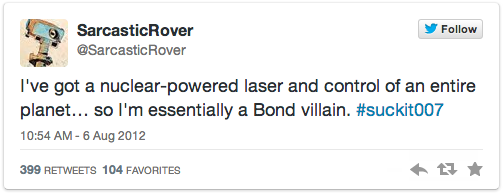Modern economic growth is driven by innovation and technology. In partnership with the Colorado Business Roundtable, this issue of ICOSA Magazine explores some of these topics in an attempt to inform and inspire leaders here in Colorado and beyond.
Technology Fills Manufacturing Skills Gap
The reality is that manufacturers are dealing with a skills gap, and have turned to technology to keep up with demand. Small and medium sized manufacturing businesses continue to grow, which is good news for business. Joe Langner is the Executive Vice President of Midmarket Solutions at Sage North America. He wrote the following article. Its tough to attract and retain the kind of talent they need to fill key positions. The talent shortage is, in part, due to a retiring baby boomer generation. And it’s not only that they are leaving, it’s that they are there is a vast amount of knowledge that is walking out the door with them.
When attracting a new generation of manufacturing workers, midsized companies don’t always have the brand name or recognition needed to catch the attention of top talent. Additionally, retaining the best of the best can be equally challenging.This is part of the reason that companies are investing in technology—to fill that gap.
There’s an increased interest in investing in technology in order to scale business, especially as the economy gets stronger. Many manufacturers are feeling the pressure to streamline their production in order to keep up with demand – and tech tools, rather than new employees, may be the first place that they invest. Forty-six percent of SMBs say that they are looking to invest in technology to both improve processes and lessen the demand for staffing increases.
Mobility, in particular, is a form of technology that many companies are seeking to use, and being pressured by their customers and contacts to use as well. It allows customers to connect with a company, without the need for an office. This ties directly into how employees are working in the modern environment. Many employees are working longer hours – including weekends – and need to be able to access important information everywhere, without having to go into the office.
Companies who are embracing mobility – including supporting the Bring Your Own Device movement – are seeing as much as an 85 percent increase in productivity. Being able to easily and accurately collect info in the field allows employees to be more efficient. Managing their time more effectively helps them get things done. This equals happier employees. When they have the tools they need to make faster decisions, they feel more empowered in their job.
For companies, being mobile is a no longer something you should do – it’s something you have to do. It just makes sense. The benefits are numerous, including an ability to conduct business when and where it happens; make faster decisions, with access to real-time information; increase employee satisfaction and overall productivity; improve sales; and provide superior customer service.
With technology, manufacturers can improve processes and reap a whole variety of benefits – often without having to make additional hires. Fill the talent gaps by improving business processes and the productivity within your existing team. The right tech tools can help you do just that.
2 Years Later: A Look at Curiosity
"The first footfalls on Mars will mark a historic milestone, an enterprise that requires human tenacity matched with technology to anchor ourselves on another world" - Buzz Aldren
August 6th, 2012 - One of the most ambitious space missions to date went into action. The unmanned space rover, aptly named Curiosity, was set to land on Mars, all that was left was the trip. After the "Seven Minutes of Terror," Curiosity was to begin its mission into the Martian wilderness. Over the course of the two years, Curiosity has been active studying the Mars for signs of life and water, reporting diligently back to NASA. Armed with cameras and a rock-vaporizing laser, Curiosity has been shooting and rocks and taking pictures for two years now, and we've learned some pretty astounding things.
Thanks to the intrepid rover, we have evidence that there was most likely once water on Mars. We now know that life on Mars was possible given the history of the red planet, and we have an idea of where to search for it. Among the many things that Curiosity has discovered on its extra-terrestrial mission, the biggest benefit from the rover may be a renewed interest in the space program. From lego sets to t-shirts to its own Twitter handle, people are interested in what's going on on Mars.
Now, 2 years later, we get a look at what the time and elements have done to our beloved space-faring friend. And maybe, just maybe, we can one day send someone up there to go meet our rover buddy and thank it for all it has done for us.
Children in the Hot Seat
We've all heard the tragic stories of a child being left in a hot car, and the horrifying results. On average in the United States, 40 children die each year, left in hot cars. Due to the combination of hot summer temperatures, and the notorious lack of shade in most parking lots - the temperature inside a car can heat up from a safe temperature to 94.3 in just two minutes. After an hour, the inside of a car could be 123 degrees, on just an 80 degree day.
Albuquerque, New Mexico high school student Alissa Chavez (17), has invented a device to alert parents if their baby is left in the car. Heartbroken over news of children left to die in their car seats, Alissa set out to create an effective warning system. Her design includes a pad that slips into the seat of an infant or child car seat, which detects both the weight of a child and increased heat levels. If the seat starts to get hot, an alarm goes off on a key fob, on your cell phone via a related app, and in your car to alert passersby.
The project started as an eighth grade science fair project that took her to regional and state level competitions. Since then she's been working with engineers to perfect the design, and now a prototype for the product she calls the "Hot Seat".
Funds for development are being raised with crowdfunding source, Indigogo, which as of this writing, has well-exceeded the $5,000 goal with a total of nearly $14,000. Alissa hopes to launch the prototype by the end of this summer.
Watch a brief video of Alissa's presentation here.
For some, it's hard to believe that a parent or caregiver could forget about their child inside a car, but something as simple as a change in one's daily routine can throw off simple memory cues, like dropping of your child at day care. Until the Hot Seat is available nation wide, it's recommended to put something you need, like the left shoe you're wearing, or purse or cell phone in the back seat with the baby so you'll always be reminded.
Murder by Smartphone?
We rarely think about the origin of the valuable components inside the items we use every day. Our smart phones, computers and tablets are made up of tin, gold, and other minerals that come from a parts of the world where conflict affects the mining and trading of those materials.To put it bluntly, in some areas, like the Congo, workers are hired at gun-point, and forced to work in extreme conditions.
Like other commodities, in which goods are extracted through questionable means, (diamonds, chocolate, even cotton) the industry is called to obtain their materials in the best possible circumstances, with as little risk to human life as possible.
The U.S. Securities and Exchange Commission, for the first time, imposed a requirement for manufacturers to file conflict minerals reports. The deadline was June 2nd, and the reports varied greatly in detail and clarity. As The Guardian reports, "Some tech giants that have taken a lead on this issue - such as Intel, HP and Apple - filed in-depth reports last week. Meanwhile others, including Herman Miller, Soda Stream, and Oracle, can best be described as vague."
As part of the 2010 Dodd-Frank Wall Street Reform and Consumer Protection Act, U.S. companies are required to report whether they use conflict minerals - raw materials like gold, tungsten, tantalum and tin - from the Democratic Republic of the Congo (DRC) and neighboring war-torn countries. It calls for transparency from consumer electronics companies, who must now examine and reveal their global supply chain.
Apple was one of the first to reveal their conflict mineral information in a Supplier Responsibility Report earlier this year. Their new filing, goes into more detail.
From a Slate.com report;
In 2013, Apple used 205 smelters, 21 of which got metals from the Democratic Republic of Congo—a country whose economy has been complicated and obscured by civil war. Four of the 21 DRC smelters have not yet been verified by third-party auditors as conflict-free.
HP reports that of 201 smelters it could identify in its supply chain, 60 are accredited. HP took steps to evaluate the other smelters and encourage them to improve their compliance, but in 2014 they will be continuing to "further mitigate risk and improve due diligence."
Meanwhile, as Bloomberg reports, Intel has a five-person team working with smelters and tracing the money that goes through them. Intel reported an 83 percent response rate on surveys it sent to smelters. The company can find 158 smelters associated with its supply chain, 71 of which are certified conflict-free. As the initiative has gained recognition it has begun to spread to other companies.
It all goes too deep to expect consumers to research where these materials come from. But reporting requirements may eventually set all our minds at ease. According to the reports filed, we still have a long way to go to be confident that the phone in the palm of our hand, didn't come from the result of innocent deaths.
To understand more about conflict minerals, Source Intelligence offers this infographic:
For the full articles quoted in this story go to Slate.com and TheGuardian.com http://www.slate.com/blogs/future_tense/2014/05/30/apple_hp_and_intel_have_reported_their_sources_for_conflict_minerals_to.html
http://www.theguardian.com/sustainable-business/2014/jun/02/sec-conflict-mineral-deadline-reports-mixed-apple-intel-hp
Where Are All the Women? Right here.
Where are all the women? I hear this question at almost every technology and start up event I cover. Guess what?
We found 'em!
The Colorado Technology Association and Women in Tech hosted their annual holiday party this year at Footer's Catering. The event was electric. Check out some of the highlights:
Join your women-in-technology peers in a series of events each year that range from content-rich speakers to fun-casual networking. This peer-to-peer forum started in the fall of 2007 as a once year networking get together, and has quickly grown to a program with incredible speakers and mentoring. To learn more visit Colorado Technology Association.
Sustainable Energy in the U.S. Military
The United States military recognizes the need for sustainable energy. In August the Army established the Energy Initiatives Office Task Force to develop renewable energy projects and improve energy security. This is a concern because providing energy to remote military locations is dangerous as well as the possibility of the military communications being offline. In fact one of eight army causalities is a result of protecting fuel convoys. New energy technology can save lives, money and the environment. In Iraq from 2003 to 2007, 3,000 people died protecting fuel convoys. The fuel is used to run generators which provide electricity for communications. The end cost is $40.00 per gallon which includes all aspects of getting the fuel to remote locations. One reduction to using fuel is providing solar panels that are easily rolled up into an individual’s backpack. On base solar panels can be mounted on trailers. The Department of Defense is interested in micro-grids to provide electricity to the military in an energy crisis. As new energy products are provided and/or developed both by the military and business, most importantly lives will be saved.
For further reading please, visit: http://rmenergyblog.blogspot.com.
Related articles
- Are Renewables Vital to Our Nation's Security? (enerdynamics.com)
Energy 101 with Kelly de la Torre
 Access to power is key and we are so very plugged into it. U.S. consumers need to realize consumption has global affects. Think of every plastic object and know oil energy probably powered its creation.
Access to power is key and we are so very plugged into it. U.S. consumers need to realize consumption has global affects. Think of every plastic object and know oil energy probably powered its creation.
Energy production has a bad reputation of harming the environment even though regulatory practices are enforced to protect it. “Fracking is the process of initiating and subsequently propagating a fracture in a rock layer, by means of a pressurized fluid, in order to release petroleum, natural gas, coal seam gas, or other substances for extraction,” Charlez, Philippe A. (1997), Rock Mechanics. This process can have detrimental environmental implications.
To learn more about energy regulatory practices, visit the Rocky Mountain Energy Blog: http://rmenergyblog.blogspot.com. Blogger and energy sector attorney, Kelly de la Torre, blogs about energy regulation, energy innovations in wind, solar, geothermal, hydro and biofuel. De la Torre believes collaboration involving all energy sectors is needed to maintain and support both consumption now and the expected doubling energy needs that will come with year 2030.
Energy production is an issue at the forefront―consequently so is the energy grid. Discussions on grid accommodations and security such as cyber-attacks, pipeline security and energy transmission are needed.
Leaner energy users are considered a 5th fuel. Innovation will propel us forward, says de la Torre. Tough issues in innovations using garbage, biofuels, wind, solar and geothermal need to be collaboratively worked so that energy is sustainable.
Agloves
Agloves® is a patent-pending winter touchscreen glove company based in Boulder, Colorado which currently employs seven streamlined employees. The remarkable founders are Jean and Jennifer Spencer. Together they developed gloves with a silver (Ag) element which is a conductor for the bio-electricity that comes from ones fingers which is needed to activate a touch screen. The origin of Agloves derives from the element symbol for silver―Ag, (Agloves).

Through connecting with the technology industry such as the Boulder Open Coffee Club, Agloves launched within months and by the second month of business were selling Agloves internationally. Jean Spencer attributes four elements to success; 1. Analyze the market beyond the obvious demographic, 2. Establish who is going to pay for it, 3. Consider manufacturing locations, 4. Utilize social media such as LinkedIn to find industry peers and ask for best practices. International business comes with challenges such as customs, duties, and exporting. One essential to customer care is considering the most efficient method to ship product to customer. In researching for a method Agloves found that having multiple manufacturers and warehouses internationally has value.
IFA, Consumer Electronics Unlimited hosts the world’s largest trade show for consumer electronics and the results from Agloves attendance is that it opened up 11 countries to sell in. Agloves also partners with the U.S. Air force, and the U.S. Army to provide Agloves to all solders.
An important social media element is Twitter since 6% of sales generate from that effort. Agloves shared social media guidelines they follow; 1. Be human on the web, share things that are of interest, funny and respond to questions, 2. Learn to use Twitter, and 3. Be photo happy.
Agloves goals are to; 1. Build buzz, 2. Establish the brand, and 3. Expand to niche markets.
Related articles
- How to Get More Twitter Followers (sweetbusiness.org)
- Silver Gloves Said to Ease Cold-weather Touchscreen Use (pcworld.com)
NASA Wins $17.9 Billion
On Friday, the U.S. Senate and the House of Representatives approved the $17.9 billion 2015 budget for NASA. The approved budget was $250 million more than 2013 and nearly $440 million more than the amount originally requested by the White House. This will ensure continued funding for NASA's two human transportation projects - the Orion Multi-purpose Crew Vehicle and the Space Launch System (SLS) - so that it can end its dependence upon Russia for space station access by 2017. Check out NASA's slide-deck outlining what they'll be developing next year:
Colorado’s Collaboratory
Collegiate rivalries get a lot more headlines than collegiate collaborations. The media’s focus on collegiate competition is as true in Colorado as it is across the nation. But here in Colorado, the reality is that we’re home to one of the nation’s strongest university collaborations, made even stronger by the participation of an internationally acclaimed federal laboratory. The Colorado Energy Research Collaboratory is a six-year-old research consortium among the Colorado School of Mines, Colorado State University, the National Renewable Energy Laboratory (or NREL, a U.S. Department of Energy lab) and the University of Colorado Boulder. Independently, each of the four institutions has world-class clean energy research programs. Together, the four institutions comprise the most powerful clean energy research center in the world.
A Uniquely Successful Collaboration
The Collaboratory was formally launched in January, 2007, with three principal goals: to create and commercialize clean energy technologies, to serve as an economic driver for the State of Colorado and to train the next generation of scientists and engineers in energy disciplines. Nearly seven years later, the Collaboratory continues to thrive and expand.
The Collaboratory began to take shape in early 2006, with multi-institutional and bipartisan support from the outset. Then-Senator Ken Salazar invited the leaders of NREL and the three universities to engage in a conversation about collaborative research. Former Senator Hank Brown, then serving as the President of the University of Colorado System, immediately offered his support to the effort, as did the leaders of CSU, Mines and NREL. With the commitment of all four institutions, the Colorado General Assembly—with the critical support of Governor Bill Owens—enacted legislation to provide state funding to be used solely as “matching funds,” which were essential to attract federal research funding.
The state funding provided between 2007-2009 played a critical role in the success of the Collaboratory. In total, the General Assembly provided $6 million over the course of those years. From January, 2007 through the end of 2012, the Collaboratory employed that $6 million to attract more than $50 million in federal, industry and other private funding to the Colorado institutions and the Colorado economy, a return to the state of more than 8 to 1, making good on the Collaboratory’s commitment to serve as an economic catalyst for Colorado. That was only the beginning.
Outstanding Research Drives Economic Development
Federally funded research grants to Collaboratory institutions include advanced biofuels, algal biofuels, new materials for photovoltaic cells, the physics and chemistry of geologic sequestration of carbon, and, most recently, the potential to use beetle-killed timber as feedstock for the production of biofuels.
Industry funded projects have focused on renewable energy technologies such as the production of fuels and industrial chemicals from biomass (wood chips, crop residue, algae, etc.), solar and wind power, and research to reduce the adverse environmental impacts of fossil fuels by capturing and sequestering carbon dioxide and other gases that contribute to climate change. Over the past seven years, more than 50 companies have engaged with the Collaboratory institutions in these research efforts, from small Colorado start-ups to Fortune Global 100 companies, including: Abengoa Solar, Applied Materials, Ascent Solar, Chevron, ConocoPhillips, Cool Planet, Dow Chemical, DuPont, Ecopetrol-IPC, General Motors, Gevo, Kimberly Clark, Lockheed Martin, Mitsubishi, OPX Biotechnologies, Rentech, RES Americas, Sharp, Shell Global Solutions, Suncor, Sundrop Fuels, SunEdison, Tokyo Electron, Total, Toyota, Valero, Vestas, WindLogics, W.R. Grace, Weyerhaueser and ZeaChem.
In the coming months, the Collaboratory will launch new cooperative research efforts in energy storage technologies, such as batteries, fuel cells and thermal storage for electricity generation. And, in the coming year, the four institutions will commence collaborative research focused on energy systems management, improving both reliability and efficiency at all scales – from heating, cooling and providing electric power within a single building, to ensuring the reliability, efficiency, security and sustainability of regional power grids.
As our research portfolio has expanded, so too have our research partnerships. The National Oceanic and Atmospheric Administration (NOAA) and the National Center for Atmospheric Research (NCAR), both based in Boulder, have partnered with the Collaboratory, and we include respected researchers from nearby universities on a project-by-project basis.
- What’s the Magic?
The Collaboratory succeeds because of the strong commitment from the highest echelon of institutional leaders to the youngest faculty members and research professionals in each institution. A mutual respect prevails among the researchers at the four institutions. Not surprisingly, talented researchers are anxious to work with others who share their interests. Recognizing the potential benefits, the leaders at NREL and the universities have given their researchers the green light to enter into research activities with their peers at the other Collaboratory institutions, and the researchers have enthusiastically embraced these opportunities.
As Coloradans, we sometimes take for granted the shared commitment and mutual respect that are so much a part of our communities and our daily lives, but these are the qualities that allow the Collaboratory to succeed. In my conversations with colleagues outside of Colorado, representatives of more than a few states have commented that we’re lucky in Colorado – the public universities in these other states simply won’t cooperate. We’re fortunate in Colorado to have leaders at our universities and at NREL who understand that collaboration is the pathway to stronger institutions and to a vibrant innovation community. And we’re blessed with political leaders who value and foster this collaboration.













